
When contacting us by e-mail, correspondents are asked to include their name and full postal address and, when providing information, to quote exact book and magazine sources. The word ‘chess’ needs to appear in the subject-line or in the message itself.
| First column | << previous | Archives [27] | next >> | Current column |
Karsten Müller (Hamburg, Germany) has been analysing Rosselli v Rubinstein, Baden-Baden, 1925 and asks:
‘Did White play axb5 at some point in the endgame? If not, Rubinstein could have played ...bxa4 followed by ...Rc4 on several occasions. In the game-score as given in the ChessBase Megabase White never took on b5, which seems very strange to me.’
The score as given in virtually every source we have consulted (including pages 49-50 of Tarrasch’s tournament book) does indeed leave open the recurring possibility of ...Rc4, but we have a solution to offer: at move 42 White’s pawn move was not a4 but a3. The latter move is given on page 81 of the Russian tournament book by N.I. Grekov (Moscow, 1927), as shown in the excerpt below:

The full game-score as given in the Russian book is: 1 e4 e5 2 Nc3 Nf6 3 Bc4 Nxe4 4 Qh5 Nd6 5 Qxe5+ Qe7 6 Qxe7+ Bxe7 7 Bb3 Nf5 8 Nf3 c6 9 O-O d5 10 Re1 Na6 11 d4 h5 12 Ne2 Nc7 13 c3 f6 14 Ng3 Nxg3 15 hxg3 g5 16 Bd2 Bf5 17 Re3 Kd7 18 Rc1 Bd6 19 Bc2 Bxc2 20 Rxc2 Rae8 21 Bc1 Rxe3 22 Bxe3 Ne8 23 Re2 Ng7 24 Bd2 Nf5 25 Re1 c5 26 dxc5 Bxc5 27 Kf1 h4 28 gxh4 g4 29 Nd4 Bxd4 30 cxd4 Rxh4 31 Bc3 Rh1+ 32 Ke2 Rh2 33 Rg1 Nh4 34 g3 Nf5 35 b3 Ke6 36 Bb2 a6 37 Bc3 Nd6 38 Ke3 Ne4 39 Be1 Kf5 40 Rf1 Rh8 41 Kd3 b5
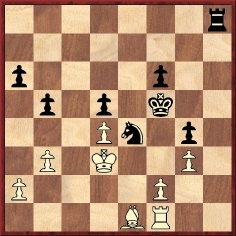
42 a3 (And not 42 a4.) 42...Rh7 43 Ba5 Rh8 44 Bb4 Rc8 45 Ba5 Ng5 46 Bd2 Ne4 47 Ba5 Kg6 48 Bb4 f5 49 Ba5 Rh8 50 Ke3 Re8 51 Kd3 Rc8 52 Bb4 Rc7 53 Ba5 Rh7 54 Ke3 Re7 55 Kd3 f4 56 gxf4 Rh7 57 Bd2 Nxd2 58 Kxd2 Rh3 59 f3 gxf3 60 Rf2 Kf5 61 Ke3 Kg4 62 b4 Rh1 63 f5 Re1+ 64 Kd3 Re4 65 White resigns.
C.N. 4605 asked who made the observation ‘Life is an insipid interruption of chess’. The answer is Willy de Winter. See, for instance, the cover of his book of chess cartoons Square Minded (Condesa, 2001):

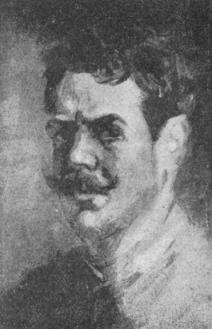
L. Nardus (self-portrait)
Joost van Winsen (Silvolde, the Netherlands) provides a summary of the charges against L. Nardus in the book mentioned in C.N. 4600, Van Cuyp tot Rembrandt. De verzameling Cornelis Hofstede de Groot edited by Luuk Pijl (Ghent, 2005):
‘The writer’s conclusion on page 77 is that Nardus appears to have been the brains behind some art forgeries (“on the American (and European?) market”) around the turn of the century. (“Vooralsnog lijkt het er in ieder geval op dat Nardus het brein is geweest achter een deel van de vervalsingen die rond de eeuwwisseling op de Amerikaanse (en Europese?) markt voor oude kunst kwamen.”)
The accusation is founded on a letter (Philadelphia, 10 September 1908) from Cornelis Hofstede de Groot to Nardus, who was then living a wealthy life in Paris. The assertions are as follows:
- The painting “De Waterval” (The Waterfall) by Jacob Ruisdael was a forgery. According to Hofstede de Groot “the paint, to put it in these words, was still wet, soft and sticky”.
- A supposed Vermeer, “De kaartspelers” (The Card Players), was a modern painting. (No explanation given.)
- Another supposed Vermeer, “Portret van een jongen” (Portrait of a Boy), was not painted by Vermeer. (No explanation given.)
- A third supposed Vermeer, “De slapende keukenmeid” (The Sleeping Kitchen Maid), was also a problem. (No explanation given.)
- Rembrandt’s “De standaarddrager” (The Standard Bearer) was a copy. The owner of the original painting was Gustave de Rothschild.
- Two supposed Memlings were also modern paintings. (No explanation given.)
- One of seven paintings attributed to Frans Hals was by his son, Jan. (No explanation given.)
- A supposed Metsu was, in fact, painted by Brekelenkam. (No explanation given.)
- Paintings purportedly by Adriaen Brouwer and Frans van Mieris were copies of famous works in Munich.
- One of the seven Cuyp paintings was a forgery. (No explanation given.)
- A supposed Rubens was a modern painting. (No explanation given.)
The above works had been sold by Nardus to Peter A.B. Widener (1834-1915), except that one of them (by Memling) was sold to Widener’s friend John Graver Johnson (1841-1917). Nardus had also sold Widener other paintings which were originals. The total number of paintings sold by Nardus to Widener is not specified. In his letter Hofstede de Groot did not accuse Nardus of fraud, but pressed him to correct his mistakes.
Nardus replied to Hofstede de Groot on 24 September 1908, denying everything. He affirmed that the paintings which he had sold included no copies or forgeries.
The book says that it is unknown how matters ended but that Widener bought two more paintings (late Rembrandts) from Nardus in 1909-11. Both were imitations. In addition, endnote 83 states that in 1907 Nardus gave a supposed Rembrandt to De Lakenhal, which is a museum in Leiden, the Netherlands. According to endnote 86, the above-mentioned document dated 10 September 1908 was Hofstede de Groot’s own rough copy of his letter to Nardus.’
As mentioned in C.N. 4600, we look forward to seeing art historians’ investigations into these claims. On one basic point, the book does not prompt confidence; page 75 has Nardus’ year of death as 1930 instead of 1955 (see C.N. 3726).
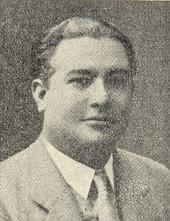
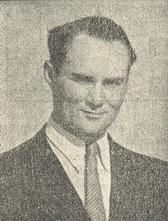
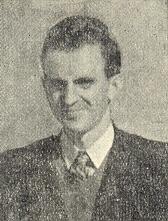
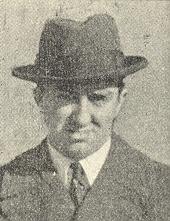
The tournament in which the four players above participated was Barcelona, 1946. From left to right: C. Guimard, A. O’Kelly de Galway, R.G. Wade and M. Najdorf. The photographs appeared in the book on the event by Rafael Lloréns:
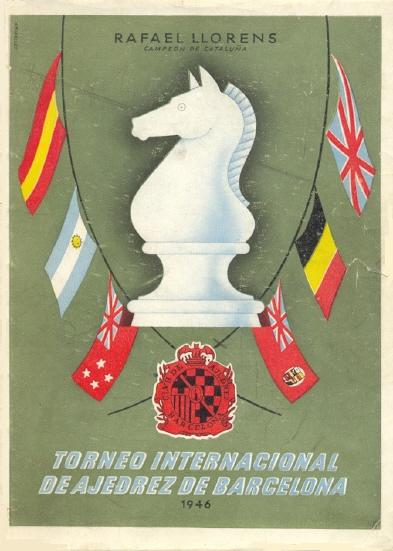
It may be recalled that we have three lexicographical feature articles:
Particularly regarding the first of these, our hope now is to increase the number of entries substantially. We are working in cooperation with John Simpson, the Chief Editor of the Oxford English Dictionary, and discoveries will be put to good use. Suggestions and citations are invited from all readers, and not only from owners of antiquarian chess literature. We are, for instance, still seeking a nomination for the first occurrence of the relatively modern phrase ‘blitz chess’. At the moment the Dictionary’s earliest entry for ‘fianchetto’ as a verb is dated 1927 (BCM, April 1927, page 168), while the first listing for the adjectival past participle ‘fianchettoed’ is as recent as 1957 (page 69 of A Guide to Chess Openings by Leonard Barden).
Arie van der Stoep (Hooge Zwaluwe, the Netherlands) submits a game from The Draughts Review, March 1928, page 58. It was contributed, with notes as cited below, by Black (C. Nelson of Brooklyn, who was playing Willie Ryan at the same time). The exact occasion was not specified.
1 b6-a5 c3-d4 2 h6-g5 g3-h4 3 g7-h6 h2-g3 4 d6-e5 a3-b4 (‘Here Willie Ryan played … g1-h2 with a draw.’) 5 a5-c3 d2-b4 6 e5-c3 b2-d4 7 c7-d6 b4-a5 8 d6-e5 c1-b2 9 e5-c3 b2-d4 10 f6-e5 d4-f6 11 g5-f4 g3-e5 12 e7-g5 h4-f6 13 a7-b6 a5-c7 14 b8-d2 e1-c3 15 f8-g7 f6-e7 16 d8-f6 c3-b4. Lasker won. (‘There may be a draw in this ending, but I got two pieces stuck on the side. I had to stand for a lot of nonsense from the “Boys” for losing to a chessplayer.’)
For other games of draughts/checkers by Lasker, see page 59 of Chess Explorations and pages 97-98 of A Chess Omnibus.
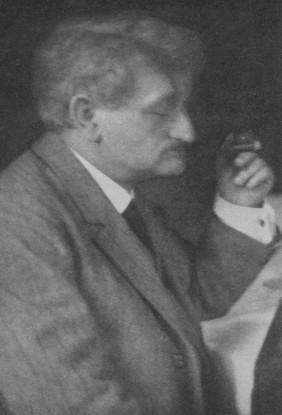
Emanuel Lasker
Regarding Professor Isaac Rice, C.N. 4521 reported that ‘his home, the Villa Julia on Riverside Drive, New York, had a chess room which was hewn out of the solid rock in the basement and was accessible by an automatic elevator which communicated with the floors above’. A little more is now added about the retreat, from an item in the New York Herald which was quoted on pages 21-22 of the November-December 1906 issue of Lasker’s Chess Magazine:
‘Proof against all the din of street and river is the sound-proof shelter deep in the foundations of the villa of Mr and Mrs Isaac L. Rice, at No. 170 Riverside Drive. The Rices are the successful leaders of a campaign against superfluous whistling of the craft which ply in the Hudson and are also the pioneers of a movement which is to bring into being the Society for the Suppression of Unnecessary Noises ...
Despite its walls of rock, unpierced by windows except at the back, this room has a free circulation of air and is one of the most cosy and comfortable apartments imaginable. ... The room is 22 feet square and there is abundant space for six chess tables and numerous leather upholstered chairs.’
The photograph below appeared on page 274 of the 1915 American Chess Bulletin (Memorial Supplement):
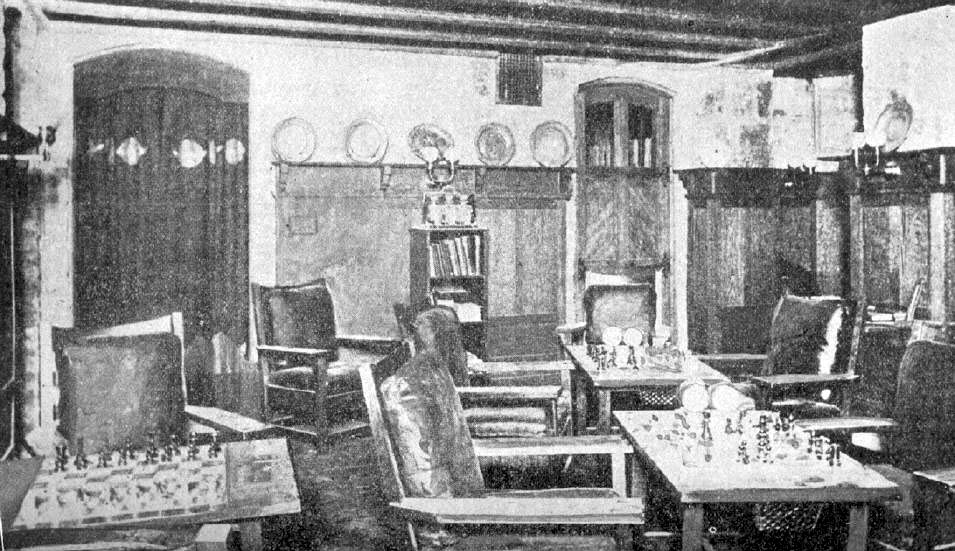
From a column by G. Koltanowski on page 3 of Chess Digest Magazine, March 1969:
‘David Bronstein is known to take a long time before making his first move. In Berlin’s Lasker Memorial, he hadn’t yet made his first move when Vassikoukov [sic] mated Zaitzev at the 15th move.’
This refers to a tournament in 1968. Apart from the consideration that the mate in question would have come at move 16, not 15, what facts are available regarding the story?
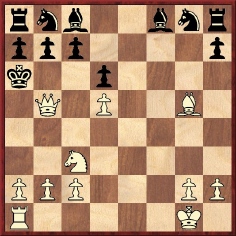
White has just played 19 Qb5 mate, but what were the moves of the game?
‘The first time in chess history where a player talked himself out of first prize’ was the phrase used by Al Horowitz about Isaac Kashdan in an article entitled ‘Legislating Morals’ on pages 20-21 of The Best In Chess by I.A. Horowitz and J.S. Battell (New York, 1965):
‘More than once has the result of an important event depended upon extracurricular third-party analysis. In the US Open, Boston, 1938 the Santasiere-Kashdan embroglio had extended to more than 120 moves. About the fourth adjournment Santasiere was a pawn to the good in a tricky ending. Nearly all the contestants submitted analysis to best Kashdan, who was a threat for premier honors. After some 20-odd hours of this wide-open sub rosa analysis, S. was positive that he had discovered the winning line; K. was equally certain that the position was a draw. Before play was resumed, however, Santasiere magnanimously exhibited the win. “Kash”, said he, “this is how I am going to beat you.” Kashdan was unimpressed. “And this”, he replied, “is how I am going to draw against you”, showing a variation which Santasiere had not taken into account. Kashdan was right. He was going to draw. But he would have been “righter” had he not spoken out of turn. For no sooner had word got around that Kashdan had found a draw than the analysts came up with a new idea, this time a clear-cut win. As matters turned out, this was the first time in chess history where a player talked himself out of first prize.’
Horowitz omitted to mention that Kashdan finished the tournament equal first – alongside Horowitz himself. The crosstable and the Santasiere v Kashdan game-score were given on page 82 of the July-August 1938 American Chess Bulletin, and the moves are also in various databases. There was a tournament report on pages 183-189 of the August 1938 Chess Review.
The photograph below shows the joint winners of the tournament and was published on page 210 of the September 1938 Chess Review:
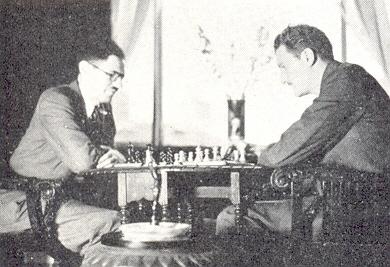
Isaac Kashdan and Al Horowitz
Richard J. Hervert (Aberdeen, MD, USA) points out that the entry on the Meran Variation in The Oxford Companion to Chess by D. Hooper and K. Whyld (Oxford, 1984) erred by stating that the opening was adopted ‘by Rubinstein and Tartakower during the Meran tournament 1924’. Tartakower was not a participant.
The mistake survived in the 1992 and 1996 editions of the Companion, the relevant part of which (page 257) reads:
‘The idea was tried in Schlechter-Perlis, Ostend, 1906, and Capablanca-Bernstein, Moscow, 1914, and a similar plan was used in the 17th match game, Steinitz-Lasker 1897, for example, but the variation came into fashion only after its adoption by Rubinstein and Tartakower during the Meran tournament 1924.’
Tartakower had already been mentioned similarly in other reference books, e.g. on page 257 of the Dictionnaire des échecs by F. Le Lionnais and E. Maget (Paris, 1967):
‘Cette ligne de jeu doit son nom à la ville italienne où Rubinstein et Tartakover la mirent à la mode au cours du Tournoi de Merano 1924.’
And from page 95 of the Diccionario de ajedrez by R. Ibero (Barcelona, 1977):
‘Esta defensa, popularizada por Rubinstein y Tartakover durante el torneo de Merano (1924) ...’
Or again, from page 131 of the Dictionary of Modern Chess by Byrne J. Horton (New York, 1959):
‘This defense receives its name from Meran, Austria, the place where Rubinstein and Tartakower popularized this opening procedure.’
The reference to Austria (instead of Italy) is also to be found on page 186 of An illustrated Dictionary of Chess by Edward R. Brace (London, 1977):
‘It was named after the Austrian resort of Meran, in which Akiba Rubinstein first played this variation during an international tournament in 1924.’
The Dizionario enciclopedico degli scacchi by A. Chicco and G. Porreca (Milan, 1971) was on firmer ground in commenting on page 182:
‘La Difesa di Merano, che si incontra per la prima volta in versione moderna nella partita Grünfeld-Rubinstein giocata a Merano nel 1924 ...’
That game between Grünfeld and Rubinstein was analysed in depth by Tartakower on pages 367-370 of Die hypermoderne Schachpartie (Vienna, 1925), and the 1906 game between Schlechter and Perlis was duly mentioned. On pages 521-523 of 500 Master Games of Chess by S. Tartakower and J. du Mont (London, 1952) the game also appeared, with the following introductory remark:
‘Moves six to ten by Black represent an appropriate defence for an enterprising player. Played for the first time in the present game, it has been named the Meran Variation.’
The Tartakower/du Mont book stated that the defence in question
arose from the moves 6 Bd3 dxc4 7 Bxc4 b5 8 Bd3 a6 9 O-O c5 (10 a4
b4). On the other hand, the two Tartakower books under discussion
disagreed on the order of the first few moves in the Grünfeld v
Rubinstein game. So do other sources, contemporary and modern.
The Oxford Companion (page 464 of the 1992/1996 edition) gave the term ‘Meran Variation’ to 1 d4 d5 2 c4 e6 3 Nc3 c6 4 Nf3 Nf6 5 e3 Nbd7 6 Bd3 dxc4, after which 7 Bxc4 b5 8 Bd3 a6 led to lines named after various players. The Meran Defense by John Donaldson (Coraopolis, 1987) regarded 7...b5 as the identifying move of the opening, as indicated by the front-cover illustration:
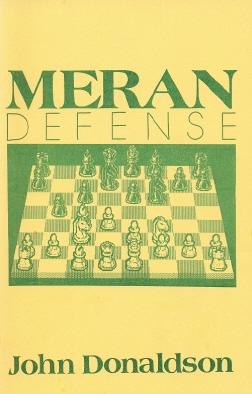
The Chicco/Porreca Dizionario, the Le Lionnais/Maget Dictionnaire and the Brace Dictionary agreed on this point, but other reference books have defined the opening otherwise. For instance, Horton’s Dictionary and Ibero’s Diccionario mysteriously give the following moves as the Meran Defence: 1 d4 d5 2 Nf3 Nf6 3 c4 e6 4 Nc3 c6 5 e3 Nbd7.
In short, the Meran terminology is chaotic, quite apart from such further appellations as the Accelerated Meran, Anti-Meran and Semi-Meran.
To these jottings we add some citations in pre-Second World War articles:
Finally, below is a group photograph of Meran, 1924. Readers are invited to try their hand at identifying all present.
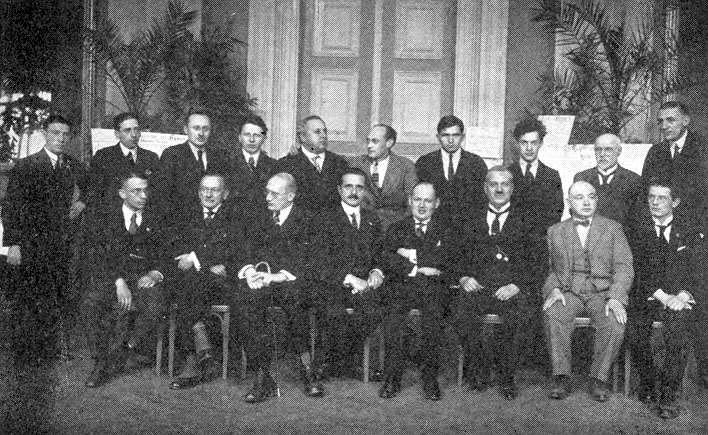
David Lovejoy (Mullumbimby, NSW, Australia) asks whether anything is known about the final disposal of Tartakower’s papers and effects after his death in Paris in 1956.
Further to our items on early uses of terms such as ‘world champion’ and ‘world championship’ (as indexed in the Factfinder), Robert John McCrary (Columbia, SC, USA) quotes the following from the 1850 volume of the Chess Player’s Chronicle (pages 318-319 and 347-349 respectively):
In a letter from ‘a member of the Calcutta Chess Club’, dated 1 August 1850:
‘I remember lately reading a suggestion somewhere that a “Grand Match” might be fitly got up on the occasion of the great Scientific Meeting projected for 1851 – a match in which the stakes should be of sufficient magnitude to induce the presence of the continental chess magnates, and which might be fairly deemed a contest for the “Championship of the World”.’
In a letter from H.A. Kennedy, dated October 1850:
‘There can be little doubt, I fancy, that all the finest chessplayers of the day, who can possibly find opportunity to attend, will be attracted by this tourney. The first-rates will gird up their loins, and march with stalwart tread into the lists, to combat à l’outrance for the baton of the World’s Chess Champion, which would be the victor’s meed ...’
This gamelet has been published many times:
1 d4 d5 2 c4 e6 3 Bf4 c5 4 Nc3 cxd4 5 Bxb8 dxc3 6 Be5 cxb2 7 White resigns. He faces not only the loss of his rook but also 7...Bb4+.
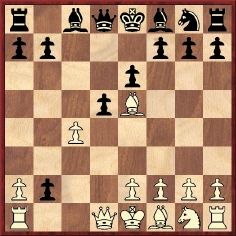
But when and where was the game played, and by whom? Page 205 of The Quickest Chess Victories of All Time by Graham Burgess (London, 1998) put ‘N.N. – R. Bruening, Berlin, 1907’, which was the same as Irving Chernev had on pages 3-4 of 1000 Best Short Games of Chess (New York, 1955), except that Black’s forename was given as Hans. Two decades later, on page 15 of Wonders and Curiosities of Chess (New York, 1974), Chernev amended the occasion to ‘Milwaukee, 1908’, which was also what Kurt Richter had stated on page 21 of 666 Kurzpartien (Berlin-Frohnau, 1966).
Although 1908 is the most common date, it is impossible, because the game had been published on page 108 of the January 1907 issue of Lasker’s Chess Magazine:
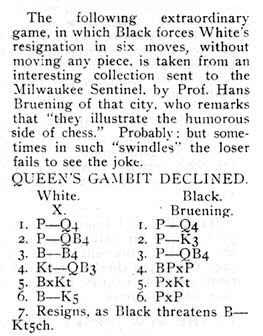
Other text (e.g. on page 124) indicates that this January 1907 number was published in February, which in turn suggests that the Bruening material appeared in the Milwaukee newspaper in late 1906 or in January 1907. Can a reader find out more?
Alan McGowan (Waterloo, Canada) writes:
‘The tournament book (Internationales Dr.-Emanuel-Lasker-Gedenkturnier 1968), published by the Deutscher Schachverband der DDR) shows that the game below (game 60, on page 61) was played in round eight:
Evgeny Vasiukov – Alexander Zaitsev
East Berlin, 25 November 1968
Caro-Kann Defence1 e4 c6 2 d4 d5 3 exd5 cxd5 4 c4 Nf6 5 Nc3 Nc6 6 Nf3 Bg4 7 cxd5 Nxd5 8 Qb3 Bxf3 9 gxf3 e6 10 Qxb7 Nxd4 11 Bb5+ Nxb5 12 Qc6+ Ke7 13 Nxb5 a6 14 Nd4 Nb4 15 Bg5+ Resigns.
The time used by each player is shown as 0.50 for White and 0.24 for Black.
The game Csom v Bronstein was played in the same round (game 61 in the book, also on page 61):
István Csom – David Bronstein
East Berlin, 25 November 1968
Caro-Kann Defence1 e4 c6 2 Nf3 d5 3 Nc3 g6 4 d4 Bg7 5 Be2 dxe4 6 Nxe4 Bf5 7 Ng3 Bg4 8 c3 Bxf3 9 Bxf3 Nf6 10 O-O O-O 11 Re1 e6 12 Bg5 Nbd7 13 Ne4 Drawn.
The time used by each player is shown as 0.50 and 1.00.
The introductory notes for the round give the following comments:
“K.o. im Caro-Kann
Mit Wasjukow – Saizew (Nr. 60) gab es die einzige Grossmeisterpaarung des Tages. Aber schon nach 74 Minuten gehörte diese Partie der Turniergeschichte an. Auf einer schachlichen Sprintdistanz über 15 Züge, die leider auch in diesem Wettstreit zur Remisspezialdisziplin erkoren wurde, kam Ewgeni Wasjukow als Sieger ins Ziel. Noch ehe die Kapitulation erfolgte, hatte es sich im Saal herumgesprochen: Saizew ist in zwei Zügen matt!! ‘Kaum zu glauben’, bemerkten Kiebitze. “Nicht solide”, meinte Grossmeister Flohr. Niemand hatte ein solches Ende ahnen können. Die Partie verlief bis zum 12. Zug in theoretischen Bahnen. Dann setzte Wasjukow ungewöhnlich fort (13 Sb5:). Auf unerschlossenen Pfaden galt es sich nun zurechtzufinden. Zwei Züge danach geschah bereits der tödliche Fehltritt (14...Sb4??), und Wasjukow fügte den Raritäten eine weitere Mattminiatur hinzu.
Allerdings fanden sie weit weniger Beachtung, weil die Würze hier nicht in der Kürze lag und manches überhaupt ohne Salz gekocht war. Csom – Bronstein (Nr. 61) zeigten die wenigsten Züge.”’
We shall be grateful to any other readers who can join in the hunt for corroboration, or otherwise, of the statement by Koltanowski quoted in C.N. 4632.
Still on the subject of miniature games, below is one from pages 181-182 of Los principios del ajedrez by Ramón Rey Ardid (Saragossa, 1939):
Ramón Rey Ardid (blindfold) – N.N.1 e4 g6 2 d4 Bg7 3 f4 e6 4 Nf3 Ne7 5 Be2 O-O 6 Be3 c5 7 c3 cxd4 8 cxd4 Nec6 9 Nc3 Qb6 10 Qd2 Qb4 11 g4 f5 12 gxf5 exf5 13 a3 Qb3 14 e5 Na6 15 d5 Ne7 16 Nd4 Qb6 17 Nc6 Qc7 18 Nb5 Resigns.
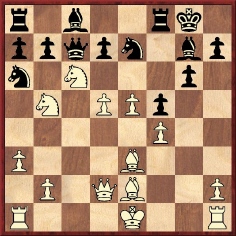
Which (future) world champion wrote that 1 d4 ‘leads to nothing’?
Since Fischer declared on page 302 of the December 1963 Chess Life that 1 e4 was ‘best by test’ (see C.N. 4423), he is an obvious suspect. And, indeed, it was Fischer who made the seemingly forgotten observation, on page 84 of the April 1964 Chess Life. His notes to the first match-game between Dubois and Steinitz, London, 1862 began:
‘The players of 1862 knew something very valuable that the players of today would do well to make note of: 1 P-Q4 leads to nothing!’
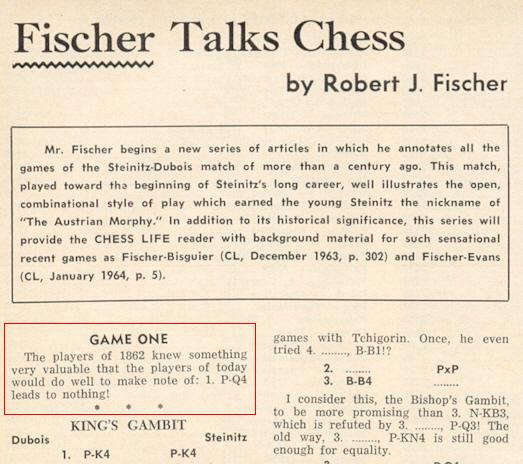
Whatever the spirit in which the remark was penned, it might have been expected to become part of mainstream Fischer lore.
Nigel Short (Athens) has been reading Capablanca’s book on the Havana, 1913 tournament and comments to us:
‘I find Capablanca’s accusations against Jaffe, and by implication Marshall, a little unbecoming. Of course, the bare game-scores do not necessarily tell the whole story, but I see nothing in the moves themselves that suggests any connivance between the two. It looks like a case of sour grapes by Capablanca, and I do not see how a 1½/2 score for Marshall against Jaffe was anything other than a fair reflexion of their difference in ability.’
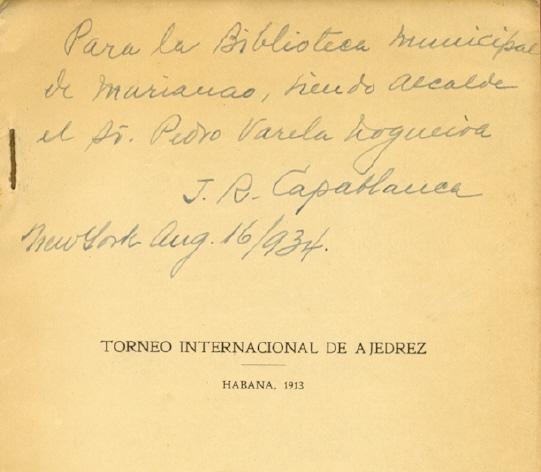
In the double-round Havana tournament Frank J. Marshall and Charles Jaffe met in rounds one and eight. The scores are given below with Capablanca’s notes:
Frank James Marshall – Charles Jaffe1 d4 d5 2 c4 e6 3 Nc3 Nf6 4 Bg5 Nbd7 5 e3 c6 6 a3 Bd6 7 Nf3 O-O 8 Qc2 dxc4 9 Bxc4 e5 10 Rd1 Qc7 11 h4 exd4 12 Nxd4 Be5 13 Ba2 Re8 14 h5 Bxd4 15 Rxd4 Qe5 16 Bxf6 Nxf6 17 Rhh4 Bf5 18 Qd2 h6 19 Qe2 Rad8 20 Rxd8 Rxd8 21 Rb4 b6 22 Qf3 c5 23 Rf4 Be6 24 Bxe6 Qxe6 25 Ne4 Nxe4 26 Qxe4 Qxe4 27 Rxe4 Kf8 28 Ke2 Rd7 29 g4 Drawn. ‘No comments have been appended to this game because the annotator is convinced that Black made no effort at all to win, and it is pointless to indicate the weakness of various moves when in fact they were played with the sole object of avoiding defeating one of the competitors.’
Charles Jaffe – Frank James Marshall1 d4 d5 2 Nf3 c5 3 dxc5 e6 4 e4 Bxc5 5 exd5 exd5 6 Bb5+ Nc6 7 O-O Nge7 8 Nbd2 O-O 9 Nb3 Bb6 10 c3 Bg4 11 Be2 Qd6 12 Nfd4 Bxe2 13 Nxe2 Ng6 14 Nbd4 Nxd4 15 Nxd4 Bxd4 16 Qxd4 Rfe8 17 Rd1 Re2 18 Rb1 Rae8 19 Be3 Ne5 20 Qxd5 Re1+ 21 Rxe1 Qxd5 22 Bd4 Re6 23 Rbd1 Rg6 24 White resigns. ‘As with the first game between these two masters, no annotations are required because it is obvious that Jaffe did not make any attempt at winning, and his blunder on the 20th move is best concealed and the game passed over.’
As noted in our feature article on Jaffe, page 5 of Jaffe’s Chess Primer (New York, 1937) stated:
‘Charles Jaffe’s career has been both remarkable and tragic. At the very height of his fame his progress was intercepted by Jose Capablanca. At the Havana Tournament of 1913 Mr Capablanca stated to the press that since Jaffe had come to Cuba for the sole purpose of helping Marshall win, he would never again play in a tournament where Jaffe was entered as a contestant. It is certainly deplorable that Messrs Cassel and Helms, the American chess correspondents, not only believed these charges but also aided Capablanca by successfully keeping Jaffe out of all those American Tournaments in which they had influence. It might be noted that the great Dr Emanuel Lasker was driven from the US by very much the same tactics. He was barred from the New York Sextet Master Tournament of 1927.’
The Capablanca v Jaffe feud was also discussed on page 48 of our book on the Cuban, where it was noted, inter alia, that after Havana, 1913 Capablanca and Jaffe never again met in a tournament.
What more can be discovered about the dispute? In particular, can forgotten statements by any of the three masters be found?
It was commented in C.N. 4389 that chessboards with a black square at h1 are too frequent an occurrence to be noteworthy, but how often has the mistake happened on the front cover of a chess book? The only instance that comes to our mind is ¿Quiere usted aprender á jugar al ajedrez?, an anonymous, undated volume published in Barcelona in the Willemanns collection:
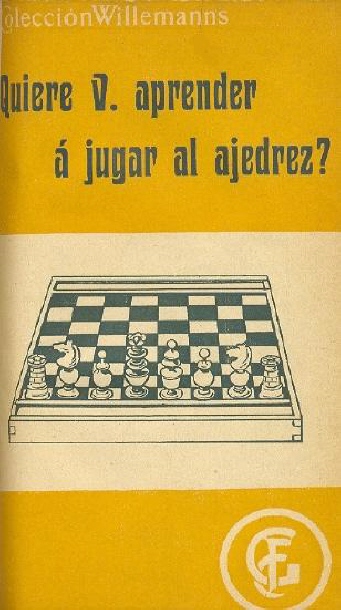
The faulty picture also appeared on page 8, but the text itself indicated that h1 should be a white square. However, the book’s only diagram with pieces was the following (on page 12):
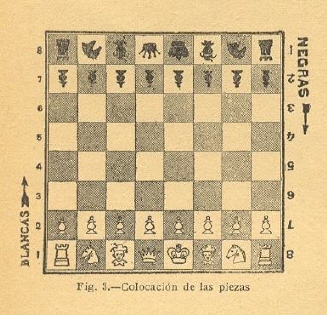
Do readers know of any specimens of ‘chess by circulation’? The procedure was explained as follows on page 47 of A Complete Guide to the Game of Chess by H.F.L. Meyer (London, 1882):
‘Three or more amateurs residing in different places agree to play a game, each making a move in turn, and each adding his name to the move made by him. The victory rests with the player who first announces a mate.’
Information is still being sought about the lesser-known chess writings of Alfred Kreymborg. The latest specimen we have found is his complimentary review of Edward Lasker’s The Adventure of Chess (New York, 1950) on page 19 of the New York Times, 17 December 1950.
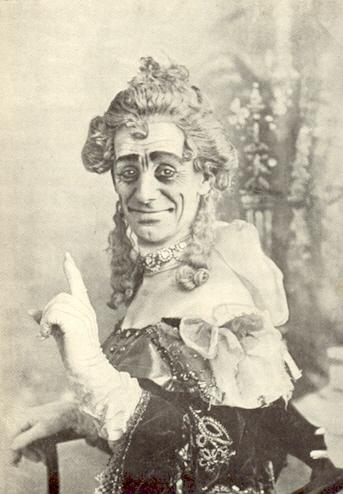
The picture in the preceding item is of Dan Leno (1860-1904), a British music-hall performer and pantomime dame who was billed as ‘the funniest man on earth’.
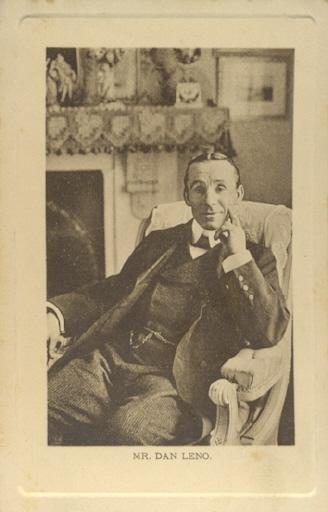
The following story, set in 1898, was published on pages 201-205 of Dan Leno by J. Hickory Wood (London, 1905):
‘It was at a café in Manchester while on this tour that Dan was challenged to play a game at chess. It came about in this way.
The smoke-room of this café was well provided with dominoes, chess- and draught-boards, and other playthings wherewith the busy Manchester man was wont to while away his dinner-hour.
Here Dan saw a spectacled youth of earnest and scholarly appearance, poring over a chess-board, and occasionally referring to a newspaper spread on the table by his side. From curiosity Dan paused and looked over his shoulder, as he had never before seen a man playing a game of chess with a newspaper as his only apparent opponent.
The youth looked up, and, seeing he was interested, naturally supposed that he knew something about the game.
“It’s a pretty opening, isn’t it?”, he remarked, handing the paper to Dan.
Dan accepted the paper; gravely examined the chess-board there portrayed, and agreed that it was as pretty an opening as he had ever met in all his experience. “And it’s very well drawn, too!”, he added as an afterthought.
“Oh, no!”, corrected the other. “It isn’t drawn at all. Can’t you see that White wins?”
“Of course”, replied Dan; “how stupid of me! Now I come to look at it again, I see that White wins. I suppose White is a very good man.”
“I beg your pardon!”, said the youth.
“Don’t apologize!”, returned Dan affably. “I don’t know the man personally.”
“Do you mean Zukertort?”, inquired the youth, looking rather puzzled. “It was Zukertort who played White.”
“I see!”, said Dan. “He played White, and lost.”
“No, no!”, contradicted the chess enthusiast, with growing impatience. “If you’ll look at the paper you’ll see that White won. It was Mason, who played Black, who lost.”
It was on the tip of Dan’s tongue to pursue the argument, and to point out to his new acquaintance that if Zukertort played White, and White won, then Zukertort must inevitably have lost; and also to inquire further what on earth that had to do with Mr Mason, who had apparently been beaten by Mr Black.
The whole thing, however, seemed to be so very complicated that he wisely desisted, and contented himself with gazing at the paper and murmuring “Exactly” in as sapient a manner as possible.
“Perhaps you have time for a game?”, suggested the youth.
“Oh, yes!”, admitted Dan cautiously, “I have time.”
“Would you like to play?”
“Yes, I would like to play chess very much indeed!”
“Come along then!” And before Dan had quite made up his mind as to whether he would go through with it or not the men were arranged on the board, and the youth was waiting for him to take the opposite seat.
So Dan, not wishing to spoil sport, obediently sat down, and wondered mildly what was going to happen next.
The youth opened the proceedings by pushing a pawn forward. That seemed fairly simple; so Dan, imitating him, also pushed a pawn forward.
The first player then advanced another pawn, and Dan, following suit, again did likewise.
Then the expert picked up one of his pieces (presumably a knight) and executed a manoeuvre with it that Dan afterwards described as being very like the zigzag flight of a snipe.
This was far beyond the powers or understanding of Leno the novice; so he, following the accepted custom as he had observed it among people who played chess, planted his elbows on the table, buried his head in his hands, and gazed steadily and raptly at the chessboard.
This species of passive resistance he prolonged so unduly that his opponent, growing impatient, felt himself constrained to remark, in a tentative manner, “Your move, I believe!”
“I know”, said Dan briefly, and without raising his head.
Another period of inaction ensued, during which the youth waxed mildly sarcastic. “I suppose you wouldn’t care to play with a time-limit, would you?”, he asked.
“Oh, no!”, replied Dan politely. “Don’t worry about me. I’ve plenty of time, thank you.”
With which remark he resumed his reverie, and maintained a masterly immobility that declined to be shaken by impatient coughs, shuffling of the feet, hints either mild or strong, or, in short, by any plan his antagonist could devise whereby to goad him into action.
At last the latter, being able to bear the strain no longer, looked at his watch, rose abruptly, and shortly remarked, in a very gruff tone of voice, “Good afternoon!”
“What! Must you go so soon?”, asked Dan, looking up in innocent surprise.
“Soon!”, echoed the other bitterly. “I’m ten minutes overdue at the warehouse now, and all through you!”
“Then it’s a drawn game”, announced Dan, rising from his seat with a sigh of relief.
“I should think you’ve played a good many drawn games in your time”, commented the youth sarcastically.
“No”, returned Dan, “this is the only one.”
“There’s one thing certain”, went on his disappointed adversary, buttoning his coat fiercely. “You’ll never be beaten! Life’s much too short for that.”
“Quite right!”, agreed Dan, with unruffled composure. “I’ve never lost a game of chess in my life.”
“I don’t believe it”, retorted the other explosively. “No man who could play chess at all would have sat for the best part of an hour worrying over a perfectly simple move such as that one was.”
“I daresay you’re right”, returned Dan. “But then, don’t you see, I can’t play chess at all.”
“You – can’t – play – chess?”, exclaimed the youth, now goaded to the fiercest indignation. “Then why on earth didn’t you say so at first?”
“I’m not quite sure”, was Dan’s reply, “but I think it must have been because it never occurred to you to ask me.”’
See also pages 97-98 of the January 1907 issue of Lasker’s Chess Magazine. We do not know the original source of the chess tale; it was not, for instance, in the volume Hys Booke.
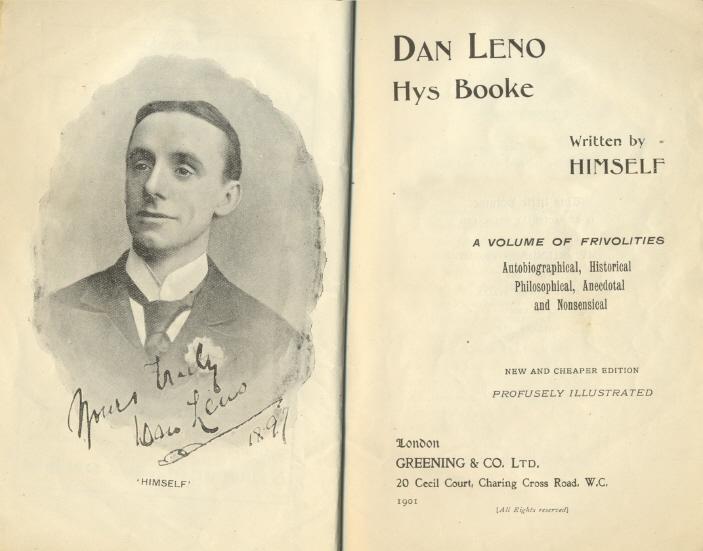
In any case, page 71 of The Funniest Man on Earth by Gyles Brandreth (London, 1977) stated that Hys Booke was ghosted by a young writer named T.C. Elder.
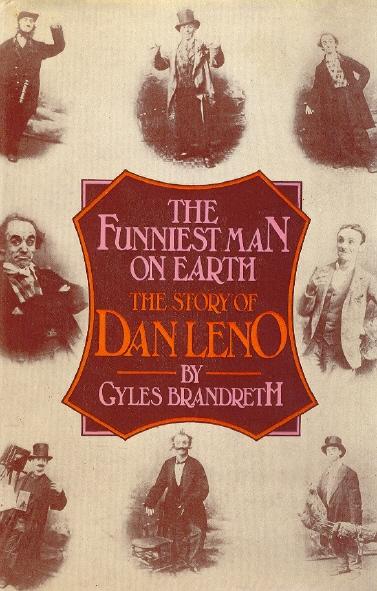
From page 12 of The Immortal Games of Capablanca by Fred Reinfeld (New York, 1942):
‘Before the 1927 match for the title took place, not a single commentator considered the possibility that Capablanca could lose the match. Some speculated that Alekhine might win a game or two, but that was the limit of their expectations.’
In the ‘Victory and Disaster’ chapter on page 115 of Capablanca’s Hundred Best Games of Chess (London, 1947) Harry Golombek wrote:
‘To the astonishment of practically the whole of the chess-playing world (Réti was the only far-sighted exception), Alekhine challenged and defeated him in a match for the world championship at Buenos Aires that very same year.’
So what exactly was predicted and by whom?
Pages 51-62 of Alekhine-Capablanca Buenos Aires 1927 by Maxim Timofeev (Rome, 2004) has a chapter entitled ‘I pronostici della vigilia’ which focuses on pre-match suggestions that Capablanca was, at least, not certain to win. It presents Italian translations of three articles:
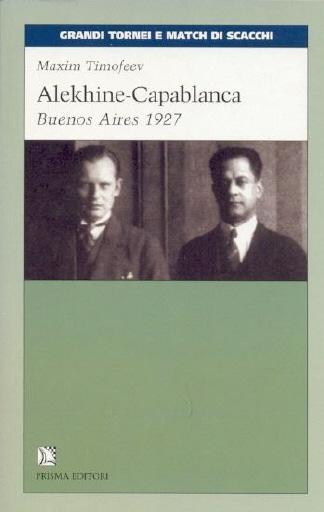
To avoid possible imprecision from using the Italian translations as intermediaries, we wonder whether a reader with access to the above Russian material could kindly send us an English version of the paragraphs containing the predictions.
Timofeev’s book also contains (pages 151-207) a digest of post-match observations by Alekhine, Capablanca, Lasker, Romanovsky, Ilyin-Genevsky, Levenfish, Réti, Tartakower, Spielmann and Brinckmann.
In the Capablanca entry on page 64 of The Encyclopaedia of Chess by Anne Sunnucks (London, 1970) – and on page 75 of the second edition (1976) – David Hooper wrote:
‘As predicted by Bernstein and others who knew Alekhine well, there was no return match.’
What more is known about the predictions of Bernstein and ‘others’?
From Chris Ravilious (Eastbourne, England):
‘By coincidence, the subject of chess book covers with a black square at h1 received a brief mention on page 38 of the October 2006 issue of CHESS. The three books mentioned there are Morphy’s Games of Chess (the Löwenthal edition of 1860), Bird’s Chess Masterpieces (1875) and F.V. Morley’s My one Contribution to Chess (1947). John Sexton’s suggested explanation for these oddities, that they arose through a misapplication of standard black-on-white print technology to the gilt inlay used on these book covers, is almost certainly correct. There may well be other examples.’
Looking further into the matter, we note that gilt inlay often resulted in the board error. For example, it occurred in subsequent editions of the Löwenthal book, including, even, the 1985 Batsford reprint. It is also worth comparing the front cover and the title page of another book by Bird, The Chess Openings, Considered Critically and Practically (London, 1878):
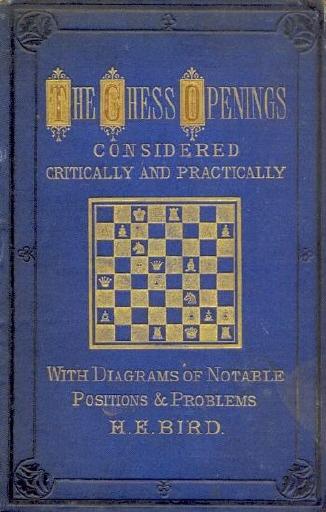
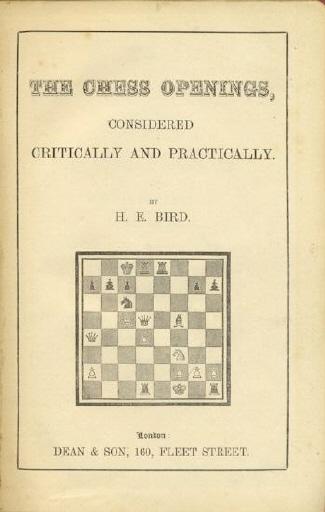
Further cases of a dark h1 square on front covers using gilt inlay include Chess: Its Theory and Practice by Captain Crawley, The Book of Chess by George H. Selkirk and Traité-manuel des échecs by Henri Delaire.
Another cover oddity concerns books by James Mason (The Art of Chess, The Principles of Chess and Social Chess). They had a 7x7 chessboard:
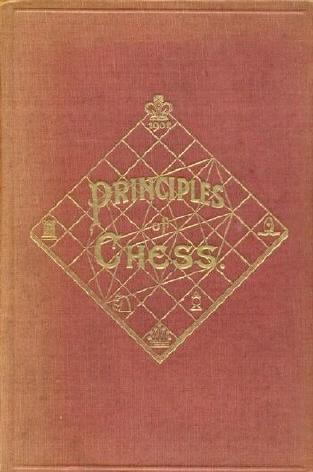
Below are inscriptions (by Morley and by Edward Lasker) in two of our copies of the New York, 1946 edition of My one Contribution to Chess by F.V. Morley:
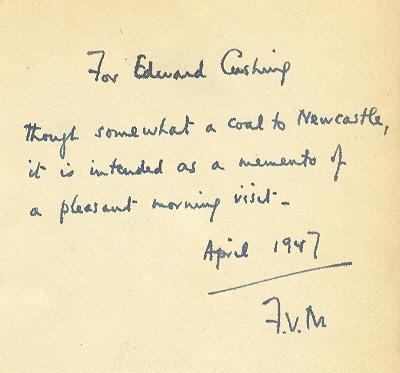
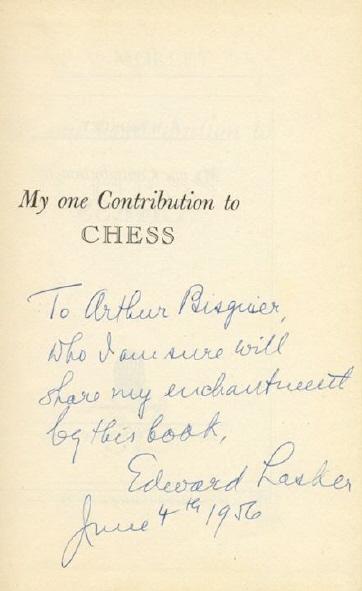
Although chess sources offer virtually no factual information about him, we note an academic webpage which reports that ‘Frank Vigor Morley (1899-1985) became a director of the publishing firm Faber and Faber but was also a mathematician who collaborated with his father for over 20 years’. Regarding Frank Morley senior (1860-1937) the same source affirms:
‘We mentioned that Morley was a chess enthusiast while at school and, indeed, he was an exceptionally good chess player ... He played at the highest level and beat Lasker on one occasion while Lasker was world chess champion.’
David McAlister (Hillsborough, Northern Ireland) writes:
‘A “circulating game” was published on pages 20-21 of the Chess Monthly, September 1883, having been started by J.B. Muñoz on 16 August 1882:
The concluding note stated that on 14 March 1883, after 35 moves, “the game was handed to Sheriff Spens, Glasgow, who, being satisfied that the game was lost for White, as Black can now force the exchange of rooks and win with his pawns, resigned and returned the same to J.B. Muñoz”. So, in fact, the stated conditions in this case varied slightly from those given by H.F.L. Meyer (C.N. 4644), and Spens did not follow the terms set out. Also, while the game does seem won for Black, resignation looks premature; I am not even sure whether the rooks can be forced off.
1 e4 e5 2 f4 exf4 3 Bc4 Qh4+ 4 Kf1 g5 5 Nc3 Bg7 6 d4 Nc6 7 Nf3 Qh5 8 e5 Nge7 9 Ne4 h6 10 c3 O-O 11 h4 Nf5 12 Qe1 g4
13 Bxf4 gxf3 14 g4 Qxg4 15 Nf6+ Bxf6 16 Rg1 Qxg1+ 17 Kxg1 Bxh4 18 Qe4 d5 19 exd6 f2+ 20 Kh2 Bd7 21 Qg2+ Kh8 22 d5 Rg8 23 Qf3 Ncd4 24 cxd4 cxd6 25 Rf1 Bg3+ 26 Bxg3 Rxg3 27 Qh5
27...Rag8 28 Rxf2 R3g4 29 Rxf5 Rg2+ 30 Kh1 Rg1+ 31 Kh2 R8g2+ 32 Kh3 Rg5 33 Kh2 Rxh5+ 34 Rxh5 Rg6 35 Bf1 Kg7. A win for Black.
The game, with an acknowledgement to the Chess Monthly, was also given on pages 8-9 of the 15 October 1883 issue of the Brooklyn Chess Chronicle (which was co-edited by J.B. Muñoz). At Black’s 33rd move there was an extra annotation: “Why not BxR?”.
Page 41 of the Brooklyn Chess Chronicle, 15 December 1884 gave the full score (taken from the Baltimore Sunday News) of a circulating game started by C.F. Stubbs, the chess editor of the St John Globe. J.B. Muñoz had made Black’s 21st move, replying to none other than W. Steinitz of New York. An earlier report of the game’s progress (Brooklyn Chess Chronicle, 15 June 1884, page 135) referred to “the moves so far made in the ‘Tramp’ or circulating game”.
The Brooklyn Chess Chronicle, 15 February 1884, page 69, gave the game-score up to move ten of a circulating game, started in England but with a number of eminent continental players making moves: 1 f4 Newham 1...d5 Lewis 2 e3 Marriott 2...Nf6 Hamel 3 Nf3 Frendsorf 3...e6 Bier 4 Be2 Schallopp 4...c5 Minckwitz 5 d4 Lange 5...Nc6 Beck 6 b3 Barnes 6...Bd6 Mandl 7 O-O Fritz 7...cxd4 Kürschner 8 exd4 J. Schwarz 8...O-O Weiss 9 c4 Hrubý 9...b6 A. Schwarz 10 Nc3 Erkel 10...Ne7 Berg, who sent the game to Noa.
Another circulating game (an Evans Gambit, up to move ten) was published on page 178 of the Brooklyn Chess Chronicle, 15 September 1884. It was started by K.D. Peterson of Milwaukee (who played Black’s 13th move in the Stubbs game), and the players of the ninth moves were the distinguished pair W. Steinitz (White) and G.H. Mackenzie (Black).’
Jan Kalendovský (Brno, Czech Republic) submits the following game from page 6 of Dziennik Poznański, 10 April 1931:
Antoni Wojciechowski – Akiba Rubinstein1 e4 e5 2 Nf3 Nc6 3 Bb5 a6 4 Ba4 Nf6 5 O-O d6 6 Re1 b5 7 Bb3 Na5 8 c3 Nxb3 9 axb3 c5 10 Na3 Bb7 11 d3 g6 12 c4 b4 13 Nc2 Bg7 14 Ne3 O-O 15 Bd2 Bc8 16 Qc1 h6 17 h3 Kh7 18 Nf1 Ng8 19 Ng3 f5 20 exf5 gxf5 21 Qc2 f4 22 Ne4 Bf5 23 Kh2 Nf6 24 g4 fxg3+ 25 Nxg3 Bg6 26 Re3 Nh5 27 Rg1 Nf4 28 Ne4 Ra7 29 Rg3 Raf7 30 Qd1 Bf5 31 Bc1 Bf6 32 Re1 Qd7 33 Bxf4 exf4 34 Rgg1 Bd8
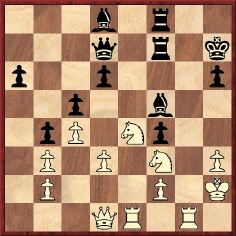
35 Nfg5+ hxg5 36 Qh5+ Kg8 37 Nxg5 Rg7 38 Ne6 Qxe6 39 Rxe6 Bxe6 40 Re1 Bf5 41 Qf3 Rh7 42 Qd5+ Kg7 43 Qxd6 Rxh3+ 44 Kg1 f3 45 Qc6 Rfh8 46 White resigns.
A computer-check indicates a number of errors in the players’ handling of the conclusion (e.g. Black’s 38th move and White’s 40th).
Aldo Lopez (Pembroke Pines, FL, USA) raises the subject of Russian books which, though not translated into English, have appeared in other languages. As an example he mentions Izbrannye Partii Ragozina (Moscow, 1964), which later that decade was published in Spanish under the title Selección de partidas de Ragozine. Information on similar instances will be welcomed. We note that in recent years an Italian publisher has been particularly active in translating biographical chess books. For example, Neishstadt’s 1971 monograph on Steinitz was brought out in 2000 by Prisma Editori of Rome under the title Steinitz primo campione del mondo. (In 2003 the same company published an Italian translation from the Czech of Jan Kalendovský’s 1989 monograph on Réti.)
Ever since C.N. 4643 raised the question of a dark h1-square on the front cover of chess books we have come across so many cases that only unusual ones seem worth mentioning. One such is referred to by Dale Lichtblau (Reston, VA, USA): as pointed out on page 255 of the May 2006 BCM, the front cover and page 18 of Smart Chip from St Petersburg by Genna Sosonko (Alkmaar, 2006) had a horizontally-reversed photograph of Tal and Spassky:
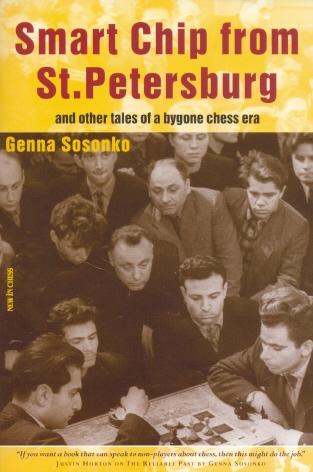
A more difficult one this time:
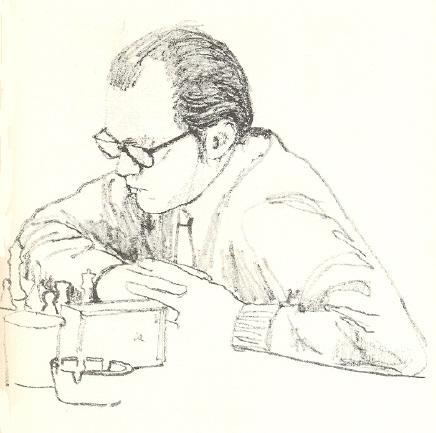
Ed Tassinari (Scarsdale, NY, USA) asks what became of the Ecuadorian player César Muñoz, who defeated Bobby Fischer in the 1960 Olympiad in Leipzig.
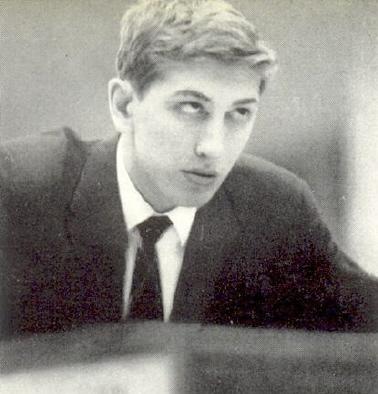
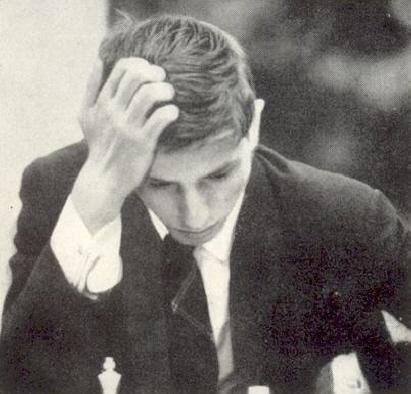
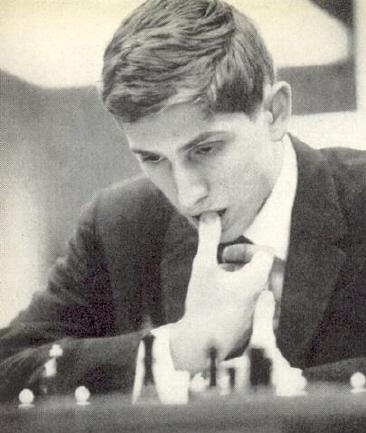
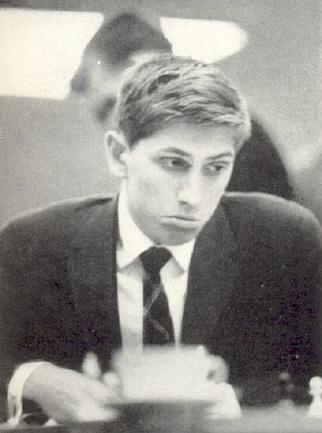
The portraits of Fischer reproduced above appeared on pages 42-43 of XIV. Schach-Olympiade Leipzig 1960, published by Sportverlag Berlin.
Michael Riordan, who is the Archivist of St John’s and The Queen’s Colleges, Oxford, informs us:
‘E.A. Michell entered The Queen’s College on 16 January 1902 as a commoner. He gave his address as 26 Victoria Road, Kensington, London. In the entrance book under the heading “school” he entered “private tuition”. He left the College in the summer of 1905, having just taken third-class honours in English.’
To our feature article we wish to add an entry in the category ‘Introduction for children’ but are hesitating between two or three titles. To tilt the balance, suggestions from readers are particularly welcome.
C.N. 3949 quoted a German book published in 2003 which ascribed to Leo Tolstoy the quote ‘Ich bedauere jeden, der das Schachspiel nicht kennt. Bringt es schon dem Lernenden Freude, so führt es den Kenner zu hohem Genuss’ (‘I pity anyone who has no knowledge of chess. While it already brings pleasure to a student, it is the source of great delight to a connoisseur’).
Richard Forster (Zurich) now points out that this quote was also ascribed to Tolstoy, again without any source, on the inside back-cover of the brochure 125 Jahre Münchener Schachclub 1836-1961:
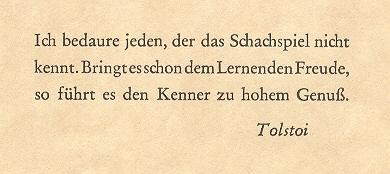
From Luca D’Ambrosio (Bolzano, Italy):
‘Widely varying dates are given for Selesniev’s death. For example, the entry in Chicco and Porreca’s Dizionario enciclopedico degli scacchi has 1925, whereas Jeremy Gaige states that Selesniev died in 1967, in France.’
It is indeed strange to find so much contradictory information in chess reference books, and below we have put together a non-exhaustive list regarding Selesniev’s death:
We note that the last of these books also states regarding Selesniev:
‘En 1935, il a publié 35 Endspielstudien.’
In fact, as mentioned in C.N. 2603 (see page 44 of A Chess Omnibus), that work was by Emanuel Lasker and was published in 1919. Below are the first two pages of text:
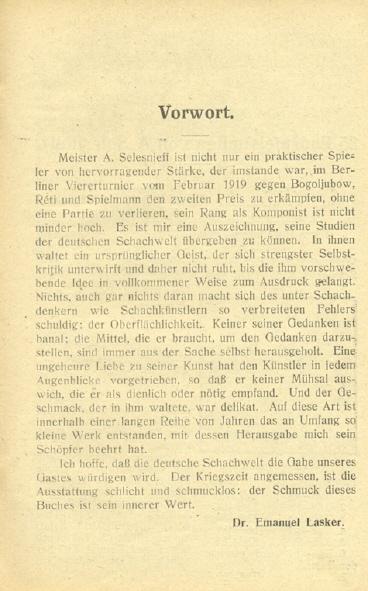
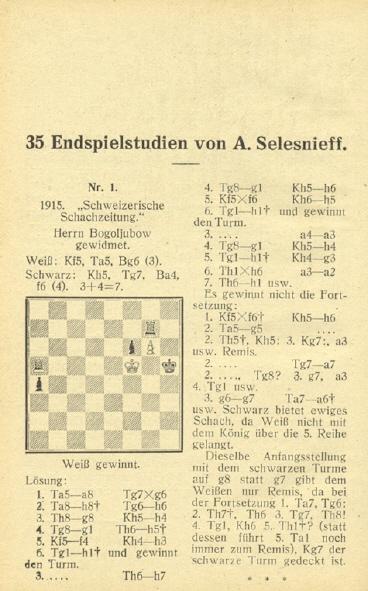
Arie van der Stoep (Hooge Zwaluwe, the Netherlands) sends some references to chess masters (Marshall, Lasker and Banks) in draughts literature:
The Draughts World, July 1910, page 3:
‘Mr F.J. Marshall, the great American chessist, like Pillsbury, is also an expert draughts-player. At the rooms of the YMCA, New York City, he recently played 15 games simultaneously at chess and 15 at draughts. He won 14 games at chess, losing one; and 13 at draughts, losing one and drawing one.’
The Draughts World, July 1911 (cover):
‘Some years ago, Mr Lasker, the world’s champion at chess, made himself fairly acquainted with some of the leading lines of play in checkers, as given by the old authors, and while located at Chicago giving chess exhibitions, with an occasional game of checkers, he played the game up to this stage (L0 20-16) and remarked: “Now, the books play 9-14 here, instead, I go 3-7, 23-18, 7-11, 16-7, 1-12 and win for Black with a piece down.” The remark was addressed to a very prominent Chicago checker-player, who immediately responded with 17-14, 10-26, 31-22, winning for White, and incidentally demonstrating the subtlety of checkers.’
The Draughts Review, December 1927, page 231:
‘Mr Banks was playing ten games blindfolded. Among the players were Alfred Jordan (he was always glad to play) and Dr Lasker, the chess champion.’
In addition to the well-known group photograph of Hastings, 1895 there exists a second one which, offhand, we recall seeing in only one book, i.e. in the plates section between pages 256 and 257 of Storia degli Scacchi in Italia by A. Chicco and A. Rosino (Venice, 1990). Not all the participants in the tournament were featured, and additional figures included the ill-fated Norman Willem van Lennep (1872-1897), who was in Hastings as a reserve player. The quality of the picture is not particularly good in the Italian book, and we wonder whether readers know of a better copy in a contemporary source.
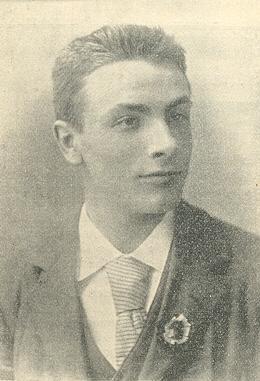
Norman Willem van Lennep
A game by the Dutchman N.W. van Lennep was given on page 113 of Kings, Commoners and Knaves, and below is another victory, played seven months before he committed suicide at the age of 25:
Norman Willem van Lennep – F.F. Gover1 e4 e5 2 Nc3 Nf6 3 Bc4 Bc5 4 d3 h6 5 f4 d6 6 Nf3 Nc6 7 Na4 Bb4+ 8 c3 Ba5 9 b4 Bb6 10 Nxb6 axb6 11 O-O exf4 12 Bxf4 Be6 13 Bxe6 fxe6 14 Qb3 e5 15 Bg3 Qe7 16 h3 Qf7 17 c4 O-O 18 Rf2 Qg6 19 Bh2 Nd4 20 Nxd4 exd4 21 c5+ Kh7 22 cxd6 cxd6 23 Bxd6 Rfc8 24 e5 Ne8 25 Rf8 Qg5 26 Qg8+ Kg6
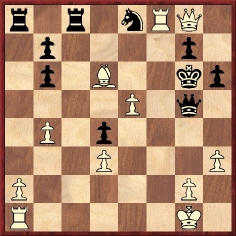
27 h4 Qe3+ 28 Kh1 Nxd6 29 Rf6+ Kh5 30 Qxg7 Rg8 31 Rxh6+ Qxh6 32 g4+ Kxh4 33 Qxh6+ Kg3 34 Rg1+ Kf3 35 Qh3+ Kf4 36 Qh2+ Kg5 37 Qh5+ Kf4 38 Rf1+ Ke3 39 Qh3+ Kd2
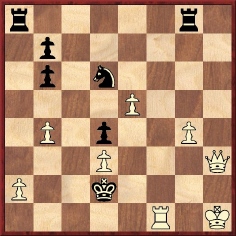
40 Qg2+ Kc3 41 Rc1+ Kxb4 42 Qb2+ Ka5 43 Qa3+ Kb5 44 Rb1+ Kc6 45 Qxd6 mate.
The game was included in a feature article about van Lennep on pages 161-166 of the May 1897 BCM. A brief extract follows:
‘Mr van Lennep’s fame had preceded him when he came to England, in August 1895, as the selected reserve of the chess masters who had entered for the International Tournament, at Hastings. At this Congress, this beardless youth could be seen holding animated discussions with Lasker, Tarrasch, Janowsky, Marco and others, respecting their endgames; often demonstrating valuable lines of play missed at crucial stages.’
Further information about van Lennep is available in Hastings 1895 Een verslag van N.W. van Lennep (Amsterdam, 1978). A 63-page booklet, it mainly comprises van Lennep’s writings, but pages 3-9 have a biographical article by Wim F. Andriessen, including six games.
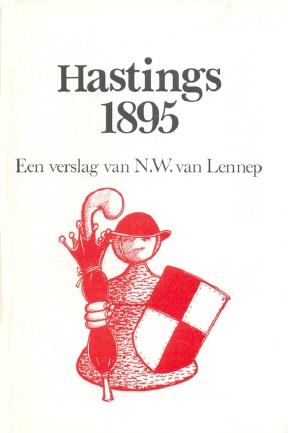
Van Lennep was also the subject of an article by Hans Ree on pages 161-165 of his book The Human Comedy of Chess (Milford, 1999).
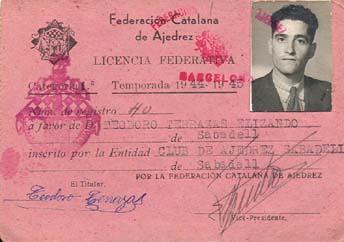 The C.N. items
listed above discussed the identity of the player named Terrazas
who competed in the Sabadell tournament of 1945. Local
documentation of the time (including photographs) suggests that he
was an adult and that his name was Teodoro Terrazas Elizando (see
the illustration), whereas the English edition of Pablo Morán’s
book on Alekhine quoted Filiberto Terrazas as stating that it was
he who had participated in the tournament, when 11 years old. At
present the mystery seems unfathomable, but we are grateful to the
editor and translator of the McFarland edition of Morán’s book,
Frank X. Mur (Oakland, CA, USA), for the following:
The C.N. items
listed above discussed the identity of the player named Terrazas
who competed in the Sabadell tournament of 1945. Local
documentation of the time (including photographs) suggests that he
was an adult and that his name was Teodoro Terrazas Elizando (see
the illustration), whereas the English edition of Pablo Morán’s
book on Alekhine quoted Filiberto Terrazas as stating that it was
he who had participated in the tournament, when 11 years old. At
present the mystery seems unfathomable, but we are grateful to the
editor and translator of the McFarland edition of Morán’s book,
Frank X. Mur (Oakland, CA, USA), for the following:
‘After Koltanowski published the Terrazas v Alekhine game, stating that the former was aged 11 in 1945, I asked him to give me the address of Terrazas, who was an expatriate in Mexico. Koltanowski did so, and Terrazas’s reply to me of 19 January 1979 included the following two sentences, the second of which was translated into English on page 227 of A. Alekhine Agony of a Chess Genius:
“Como con toda razón expresa Usted, a los 11 años de edad yo no estaba como para guardar copias de las partidas de torneo. Sólo recuerdo que la imponente figura de un Alekhine le hacía a uno jugar con un profundo temor reverencial particularmente a esa edad.”’
Robert John McCrary (Columbia, SC, USA) writes:
‘I have a candidate for the origin of the term “draw” in chess. It is found in The Famous Game of Chesse-Play by Arthur Saul (1614), in Chapter III on roughly page B3 or B4 (numbering unclear), under the heading “A Caveate for such as will condition to give a Mate”, and reads as follows:
“Imagine that two were a playing, and that many men on both sides were lost and no odes in the men of either side, so that the game were indifferent, that then I say, one of the gamsters should give over the game and draw his stake, the other at this seeming to be a-grieved, thinking his men standeth better then the others which hath given over, he saith, had you playd out the game I should have wonne it, & the other replying, demandeth what hee will lay more one the game, the party a-grieved upon this offereth a crowne more, that hee will winne the Mate, now here is a condition, which if hee performe not he looseth both his first and last stake: The way for him that taketh any man upon such condition, is still to change, and to bring it unto a dead game, and so shall he this way winne the stakes, by reason the other had tyed himselfe by obligation to give the Mate, wherefore let any one take heed how he entreth into such condition; for who so doth it giveth the other advantage, whether it be at the beginning of the mate, or after, it is all one.”
My theory that the Saul text may be the origin of the term “draw” in chess is based on two considerations: 1) it refers to an “indifferent” game, in which many men have been lost, i.e. evidently one without winning prospects; 2) according to the Oxford English Dictionary (definition number 37) the term “draw the stakes” referred at that time (before 1614) to a situation in sport in which one (with)drew either the stakes or an entry (such as a horse) from the competition. I suggest that by 1614 chessplayers were modifying that sporting meaning slightly to allow a player to “draw the stakes” (i.e. withdraw them) if a game in progress reached a simple endgame that clearly could not be won, as Saul describes.
In 1640 Joseph Barbier published a revised edition of Saul’s book. It was, in fact, a substantial rewrite which contained at least as much Barbier as it did Saul. Barbier omitted the passage from Saul referring to “draw the stakes”, but included a point with similar meaning in his proposed code of laws, in which he used the term “dead game” but not the word “draw”. At one point, Barbier defined “dead game” as a king versus king ending, but within a context that would apply just as well to any simplified, drawn ending. Since “dead game” was also used by Saul in his passage, I believe that Barbier’s terminology tends to support the idea that Saul’s use of “draw the stakes” in a passage that also referred to “dead game” was, in fact, a new application of the sporting term “draw the stakes” to drawn endgames in chess, and thus possibly the origin of our term “draw”.
The earliest use that I have found of “draw” with the modern meaning is in Richard Lambe’s The History of Chess (1764). It uses “drawn game” on pages 119, 123 and 127 and “drawn” on page 120. These antedate the OED reference for “draw” in chess (definition number 38). The three references in Lambe’s book use only the phrase “drawn game”. The first is just the words “drawn game” (no sentence) at the end of analysis of the “Queen’s Gambit, or Gambit of Aleppo”. The second (page 123) ends another game analysis with the note “It must be a drawn game, because to win the B.P. you must lose your R”.’
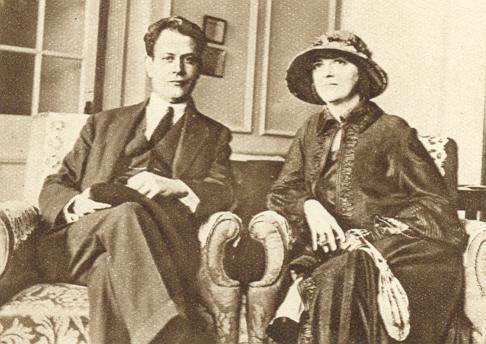
This photograph, which is likely to be new to readers, comes from page 307 of the Illustrated London News, 26 August 1922.

The above position occurred in a game published on page 27 of the November-December 1906 issue of Lasker’s Chess Magazine, being culled from the New Orleans Times-Democrat:
‘“The Hurricane Game”
The following curious little partie occurred more than 20 years ago in one of the tournaments of the New Orleans Chess, Checkers and Whist Club; indeed, so very unusual was the brief battle that it was aptly christened “The Hurricane Game” by the members of that organization. The late Dr Zukertort avowed that the peculiar situation of the black forces at the dénouement rendered the partie quite remarkable. We reproduce the moves and the notes from our column of 29 July 1888.’
The game-score was:
Benjamin Grinell Barton – F.C.1 e4 e5 2 f4 exf4 3 Nf3 g5 4 Bc4 g4 5 O-O gxf3 6 Rxf3 Qf6 7 d4 d6 8 Rxf4 Qe7 9 Rxf7 Qxe4 10 Rf4 Qg6 11 Bf7+ Qxf7 12 Rxf7 Kxf7 13 Qh5+ Kf6 14 Bg5+ Ke6 15 Nc3 Kd7 16 Qg4+ Kc6 17 d5+ Kb6 18 Qb4+ Ka6 19 Qb5 mate.
Barton was Zukertort’s umpire/second during the New Orleans stage of the 1886 world championship match (Lasker’s Chess Magazine, November-December 1906, page 26, and the International Chess Magazine, May 1886, page 118).
Luca D’Ambrosio (Bolzano, Italy) submits a key to the Meran, 1924 group photograph, based on information in L’Italia Scacchistica, 6 April 1924, page 3, and Het Schaakleven, 15 March 1924, page 125. The names in brackets below were given only by the latter publication.

Standing, from left to right:
(Balaban), E. Colle, A. Selesniev, K. Opočenský, G. Patay, S.
Takács, L. Steiner [not E. Steiner – see C.N. 4808], G.
Koltanowski, I. Gunsberg, (Michel).
Seated: J.A. Seitz, S. Tarrasch, E. Grünfeld, S.
Rosselli del Turco, R. Spielmann, L. Miliani, D. Przepiórka,
(Grim).
Our correspondent asks whether a group photograph exists of the Meran, 1926 tournament (won by Colle ahead of Canal, Przepiórka and Spielmann).
Luca D’Ambrosio and Michael McDowell (Westcliff-on-sea, England) mention that an obituary of Selesniev (using the alternative spelling Selesnieff) by Bo Göransson on pages 342-343 of EG, April 1968 stated:
‘The chess master and study composer A.S. Selesniev died in June 1967 at Bordeaux, France. He was born in 1888 in Tambow near Moscow ...
He composed ca. 200 studies (over a period of over 50 years, his first composition around 1908-09 and the last one I have seen published dates from 1962), many of those have not yet been published. We have heard that Mr Eugène Guémard, Bordeaux, (TfS 10/62 – E. Uhlin) one of Selesniev’s friends in France, has undertaken to edit a new collection of Selesniev’s studies.’
The complete obituary can be read on-line.
Noting that Aron Nimzowitsch included in his books a few of his correspondence games, Javier Asturiano Molina (Murcia, Spain) asks how many games the master is known to have played by post.
Readers’ assistance will, as ever, be welcome. To make a start, we note that Nimzowitsch gave victories over G. Fluss in both My System (game dated 1913) and The Praxis of My System (game dated 1912-13), while the latter book also had a 1924-25 game against O.H. Krause. On pages 429-430 of Kagans Neueste Schachnachrichten, 1 October 1925 Nimzowitsch presented the first 18 moves of a correspondence game he was playing against V. Edman. A postal game lost by Nimzowitsch to K. Bētiņš in a match dated 1911-13 was published on pages 55-56 of the March 1965 Chess Life.

C.N. 4656 set a little trap, since the sketch might easily be taken to depict Alekhine; compare, for instance, the photograph of the world champion opposite page 160 of Kings of Chess by William Winter (London, 1954):
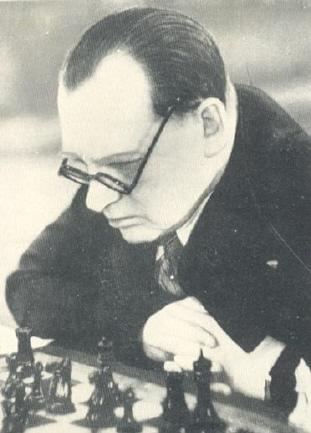
The sketch, however, was of William Addison. Source: page 12 of The 1969 United States Chess Championship and World Championship Zonal Qualifier by Morton Siegel (Newburgh, circa 1969).
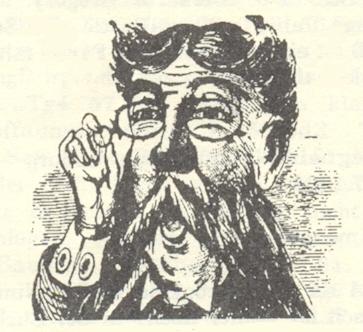
The player represented in this sketch may, or may not, prove more recognizable.
From Dominique Thimognier (St Cyr sur Loire, France):
‘I have examined the last French magazine to which Tartakower contributed, L’Echiquier de France. His death was announced on page 46 of the February 1956 issue, with a brief report on his funeral. The March 1956 number (page 51) had a more detailed article on his career, by Gabriel Authier, the magazine’s managing director. I merely note that Tartakower had no family and that he was living at the Hôtel Mazagran in Paris. L’Echiquier de France continued to publish articles by Tartakower posthumously, but there is nothing to suggest that anyone from the magazine took possession of the master’s papers.’
Mr Thimognier mentions that there was a detailed article on Selesniev by Alain Pallier on pages 59-61 of the March 2003 Europe Echecs. It states that Selesniev died in Bordeaux in June 1967, his financial circumstances having been wretched. (‘... Il va se retrouver à Bordeaux, où le maître et compositeur commencera une nouvelle vie, extrêmement modeste, de portier-jardinier chez les Petites Soeurs des Pauvres. ... Christian Caminade se rappelle un homme totalement démuni, mendiant un ticket de bus ou une bière.’)
In C.N. 4669 a correspondent asked whether a group photograph from Meran, 1926 was known to exist. Peter Anderberg (Harmstorf, Germany) reports that such a picture was published in Kagans Neueste Schachnachrichten, 1927, ‘Erstes Extrablatt’ (page 153). Since our bound volume of that year’s magazine includes the Extrablatt in photocopy form only, can a reader provide a good copy of the photograph for reproduction here?
From Karsten Müller (Hamburg, Germany):
‘The final position of Colle v Grünfeld, Carlsbad, 1929 is often given with the black king on e2, allowing Grünfeld to draw with 77...Kd3. See, for instance, page 18 of Endgame Tactics by G.C. van Perlo (Alkmaar, 2006). However, I would expect Black’s king to be on f1 in the final position. Can you shed any light on the matter?’
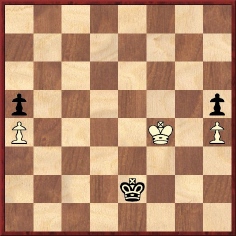
Above is the position as given in the Dutch book, which states that Black resigned here although he could have drawn with 77...Kd3 78 Kg5 Ke4 79 Kxh5 Kf5.
The game appeared, with annotations by Colle, on pages 384-385 of IV. Internationales Schachmeisterturnier Karlsbad 1929 (Vienna, 1930), where the conclusion was presented as follows:
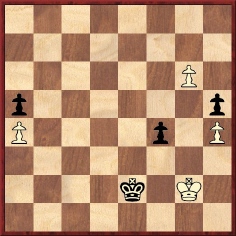
71 g7 f3+ 72 Kh2 f2 73 g8(Q) f1(Q) 74 Qc4+ Ke1 75 Qxf1+ Kxf1 76 Kg3 Ke2 77 Kf4 Resigns. This corresponds to the final position as given by van Perlo.
Colle’s notes did not mention that Grünfeld resigned in a drawn position. Was this an omission/oversight or did the drawing opportunity never arise because the game-score in the tournament book was faulty? If White’s 72nd move had been Kg3, rather than the odd-looking Kh2, there would have been no draw for Grünfeld because after the exchange of queens the white king would reach f4 at move 76, and not move 77.
The immediate question is thus whether a contemporary source exists which gave White’s 72nd move as Kg3.
Stories about Sämisch’s time-trouble are numerous, but facts remain elusive. A curiosity pointed out by Martin Weissenberg (Savyon, Israel) is a brief report about Flensburg, 1947 on page 352 of the Revista Română de Şah, November-December 1947; it states, without further particulars, that for the first time in his career Sämisch was not in time-trouble.
From item 26 in Napier’s Amenities and Background of Chess-Play (New York, 1934):
‘I remember seeing Showalter in a match game with Pillsbury brood 45 minutes over a fourth move. It was a Ruy López. Afterwards there came the explanation. “The cigar was good; and I thought that long looking might uncover some better move and sequel than those used.”’
For two instances of long thought by Wolfgang Uhlmann (1 hour 40 minutes and 1 hour 50 minutes) see page 351 of The Life and Games of Mikhail Tal (New York, 1976), or page 336 of the London, 1997 edition.
Under the heading ‘Amazing facts’ the following appeared on page 17 of Playing Chess Step-by-Step by Gary Lane (New York, 2004):
‘The slowest chessplayer ever was Louis Paulsen, who once thought for 11 hours over one move.’
This ‘fact’ of the ‘once’ variety would appear to be based on a misunderstanding. The figure of 11 hours was given, regarding the New York, 1857 tournament, on page 67 of Paul Morphy The Pride and Sorrow of Chess by David Lawson (New York, 1976) but in a different context:
‘Undoubtedly, slow playing on the part of Paulsen was the reason for time records being kept during his games with Morphy. Moves over five minutes during the second game and portions of others were recorded. During the entire second game, Morphy’s total time for moves over five minutes was only 25 minutes, while Paulsen consumed 11 hours for the same.’
The breakdown for that second Paulsen v Morphy game was given on page 246 of the tournament book:
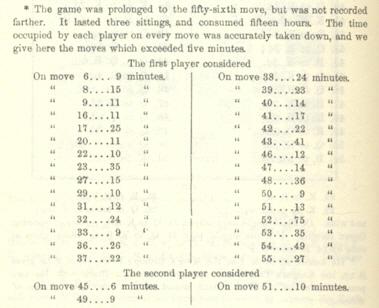
As shown below, page 248 of the tournament book indicated that the total duration of the third game between Paulsen and Morphy was 11 hours, most of it consumed by the former:
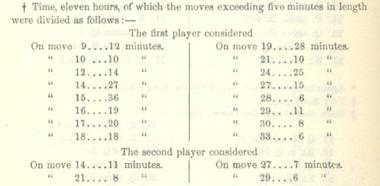
There is also the well-known anecdote about Paulsen, in play against Morphy, sitting motionless at the board and suddenly asking whether it was his move. Steinitz related it on page 46 of the February 1885 International Chess Magazine, on the authority of Thomas Frère.
We now recall that there was also an article about van Lennep, by Olimpiu G. Urcan, on pages 131-148 of the autumn 2004 Quarterly for Chess History.
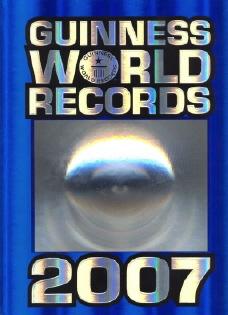
‘The world’s biggest-selling book’ is the boast on the back cover of Guinness World Records 2007 (London, 2006). Two pages include entries on chess: page 99 has a couple of dozen words about Sergei Karjakin being the youngest grandmaster, while page 137 offers brief features on the smallest and largest chess sets, as well as the following: ‘On 25 June 2005, 12,388 simultaneous games of chess were played at the Ben Gurion Cultural Park in Pachuca, Hidalgo, Mexico.’ That is all. The four entries from the 2006 edition (see C.N. 4035) have been dropped.
Although poker has five entries on page 136, games such as draughts and bridge receive no treatment at all, and the editorial team’s interests are evidently on a different plane. For example, pages 8-9 document such pivotal attainments as ‘most heads shaved in 24 hours’, ‘fastest time to drink a 500-ml milkshake’, ‘longest tandem bungee jump’, ‘fastest carrot chopping’, ‘largest underpants’, ‘most socks worn on one foot’ and ‘fastest person with a pricing gun’.
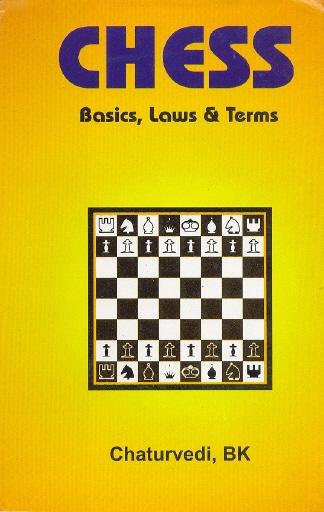
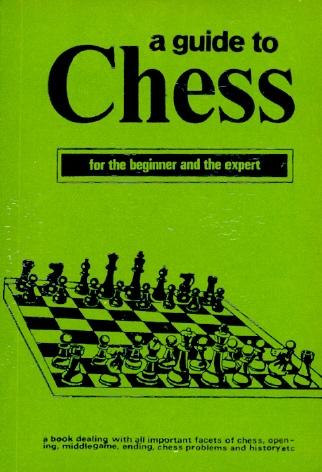
As shown in C.N. 2750 (see pages 335-337 of A Chess Omnibus), Chess (Basics, Laws and Terms) by B.K. Chaturvedi (Chandigarh, 2001) copied extensively from Chess Made Easy by C.J.S. Purdy and G. Koshnitsky. But now comes a rebondissement: is it possible that the (dire) Indian volume was itself subsequently the victim of plagiarism? Below, on the left, is a passage from page 6 of the Chaturvedi book, alongside the text on page 8 of A Guide To Chess ‘Edited and Revised by Philip Robar’ (New Delhi, 2002):
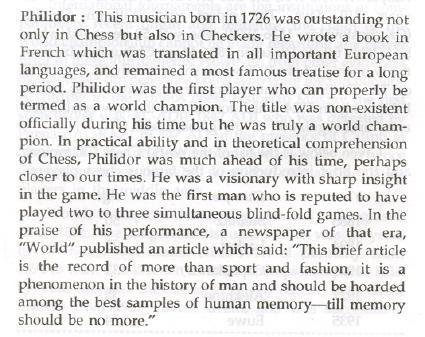
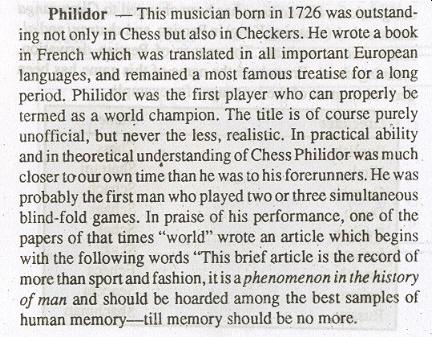
The next paragraph in both books (pages 7 and 9 respectively) is a particularly bumpy read:
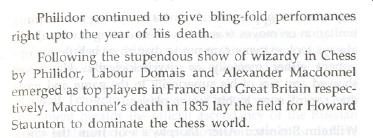

Among other examples of ‘similarities’ are the books’ concluding glossaries, but is it a plain case of plagiarism by the Robar volume? We feel that matters are far from simple. For instance, the imprint page of the Robar book states, however implausibly, ‘XIVth Edition 2002’; if there have truly been 13 previous editions of A Guide To Chess, most, if not all, of them would pre-date the 2001 Chaturvedi book. But who is Philip Robar? And what exactly was ‘edited and revised’ by him for the Guide?
A further consideration is that his name is not on the cover but only on the title page:
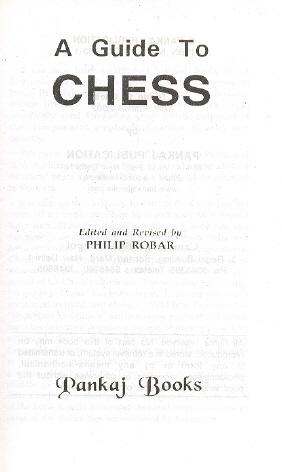
Finally for now, an additional mystery concerns the book’s spine: it names the author as ‘Dr C.P. Mithal’.
C.N. 4092 gave a photograph of the game of living chess between Capablanca and Herman Steiner in Los Angeles, 1933, and below is another one, in the top right-hand corner of which the Cuban is seated at a board:
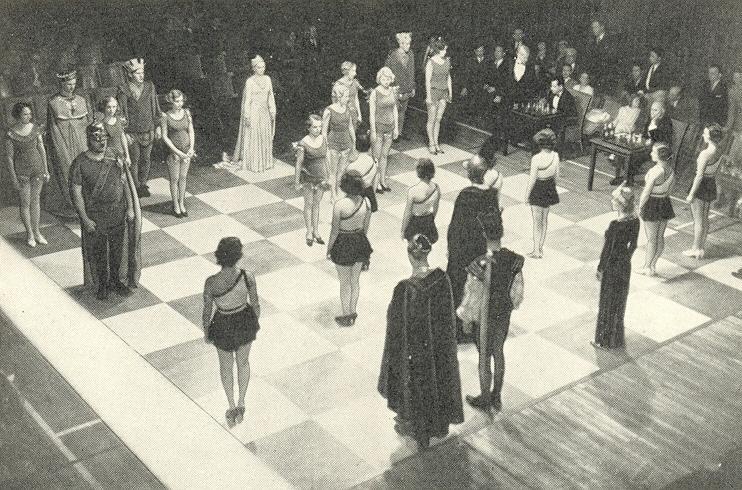
Source: page 57 of Alt om Skak by B. Nielsen (Odense, 1943).
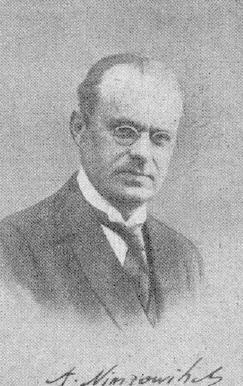
As a companion item to C.N. 4671, which discussed correspondence play by Aron Nimzowitsch, we turn now to his blindfold games. There is the familiar brilliancy against Jokstad, played in Bergen in 1921 and annotated by Nimzowitsch on pages 161-162 of Kagans Neueste Schachnachrichten, 1 April 1925, but how many others are known?
Michael Negele (Wuppertal, Germany) has provided the group photograph of Meran, 1926 referred to in C.N. 4676:
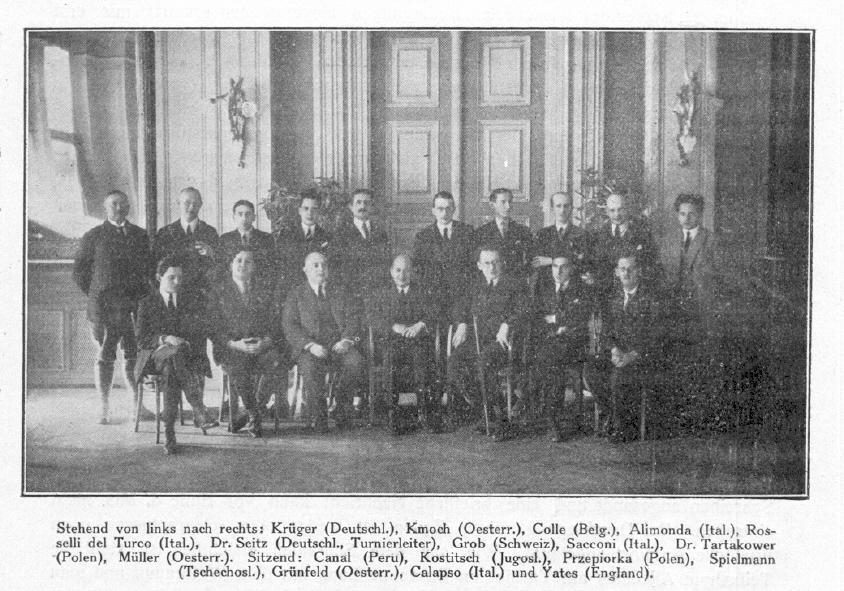
Concerning the game between Colle and Grünfeld at Carlsbad, 1929, C.N. 4677 asked whether any contemporary source could be found which gave White’s 72nd move as Kg3, and not Kh2 as in the tournament book.
No such source has yet come to light, but Christian Sánchez (Rosario, Argentina) points out that 72 Kg3 appeared in Znosko-Borovsky’s endgame book, which was published in a number of languages, the first of them being English (How to Play Chess Endings in 1940). Below is the relevant passage from page 255 of the French edition, Comment jouer les fins de parties aux échecs (Lille, 1952):
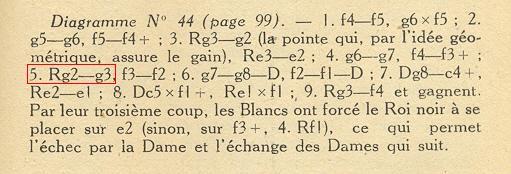
On what grounds did Znosko-Borovsky diverge from the move given in the Carlsbad, 1929 tournament book?
Javier Asturiano Molina (Murcia, Spain) draws attention to the following passage about Bobby Fischer on page 483 of ‘Garry Kasparov on Fischer My Great Predecessors Part IV with the participation of Dmitry Plisetsky’ (London, 2004):
‘In 1977 he easily defeated a computer at the Massachusetts Institute of Technology (3-0), and he crushed his teacher Collins in a training match (+16 –1 =3).’
Our correspondent asks what is known about this ‘training match’ against John W. Collins (1912-2001).
Wanted: information about any photographs of Fischer taken between the mid-1970s and his re-appearance in 1992.
| First column | << previous | Archives [27] | next >> | Current column |
Copyright 2006 Edward Winter. All rights reserved.